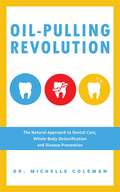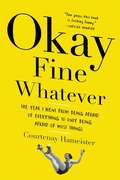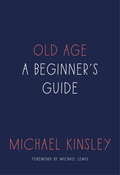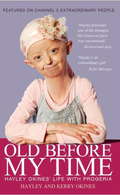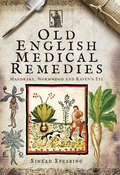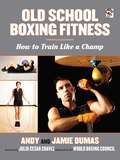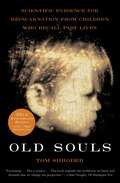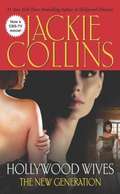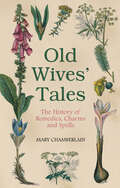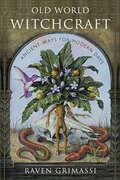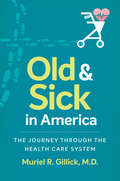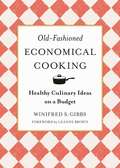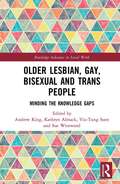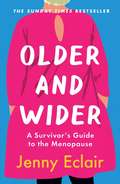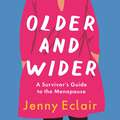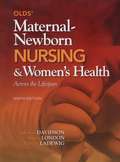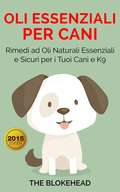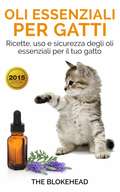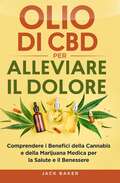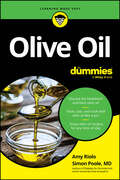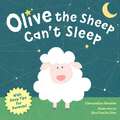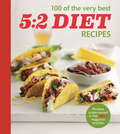- Table View
- List View
Oil Pulling Revolution: The Natural Approach to Dental Care, Whole-Body Detoxification and Disease Prevention
by Michelle ColemanA NEW, UP-TO-DATE GUIDE TO THE REDISCOVERED TRICK THAT'S BEEN A DENTAL HEALTH SOLUTION FOR THOUSANDS OF YEARS Holding and swishing organic oil in your mouth is an amazingly simple yet powerful technique for cleaning your teeth and detoxing the entire body. The Oil-Pulling Revolution combines ancient teachings and modern techniques to incorporate this healthy habit into your daily routine. Using the tips and instructions provided here you can: *Remove harmful bacteria *Eliminate cavities *Reduce plaque *Whiten teeth *Freshen breath Beyond dental care, this book details how oil pulling benefits your entire body for glowing skin, more energy, improved heart health, fewer migraines and a healthier overall lifestyle.
Okay Fine Whatever: The Year I Went from Being Afraid of Everything to Only Being Afraid of Most Things
by Courtenay HameisterThe "hilarious and poignant" story of one chronically anxious woman's quest to become braver by seeking out the kinds of experiences she's spent her life avoiding. (Cheryl Strayed) For most of her life (and even during her years as the host of a popular radio show), Courtenay Hameister lived in a state of near-constant dread and anxiety. She fretted about everything. Her age. Her size. Her romantic prospects. How likely it was that she would get hit by a bus on the way home. Until a couple years ago, when, in her mid-forties, she decided to fight back against her debilitating anxieties by spending a year doing little things that scared her--things that the average person might consider doing for a half second before deciding: "nope." Things like: attending a fellatio class. She did that. She also spent an afternoon in a sensory deprivation tank, got (legally) high in the middle of a workday, had a session with a professional cuddler, braved twenty-eight first dates, and (perhaps scariest of all) actually met someone who might possibly appreciate her for who she is.Refreshing, relatable, and pee-your-pants funny, Okay Fine Whatever is Courtenay's hold-nothing-back account of her adventures on the front lines of Mere Human Woman vs. Fear, reminding us that even the tiniest amount of bravery is still bravery, and that no matter who you are, it's possible to fight complacency and become bold, or at least bold-ish, a little at a time.
Old Age: A Beginner's Guide
by Michael Kinsley<P>Vanity Fair columnist Michael Kinsley escorts his fellow Boomers through the door marked "Exit." <P>The notorious baby boomers--the largest age cohort in history--are approaching the end and starting to plan their final moves in the game of life. Now they are asking: What was that all about? Was it about acquiring things or changing the world? Was it about keeping all your marbles? Or is the only thing that counts after you're gone the reputation you leave behind? <P>In this series of essays, Michael Kinsley uses his own battle with Parkinson's disease to unearth answers to questions we are all at some time forced to confront. "Sometimes," he writes, "I feel like a scout from my generation, sent out ahead to experience in my fifties what even the healthiest Boomers are going to experience in their sixties, seventies, or eighties." <P>This surprisingly cheerful book is at once a fresh assessment of a generation and a frequently funny account of one man's journey toward the finish line. "The least misfortune can do to make up for itself is to be interesting," he writes. "Parkinson's disease has fulfilled that obligation." <P><b>A New York Times Bestseller</b>
Old Before My Time: Hayley Okines' Life with Progeria
by Hayley OkinesHayley Okines is like no other 13-year-old schoolgirl.In Old Before My Time, Hayley and her mum Kerry reflect on her unusual life. Share Hayley’s excitement as she travels the world meeting her pop heroes Kylie, Girls Aloud and Justin Bieber and her sadness as she loses her best friend to the disease at the age of 11. Now as she passes the age of 13 – the average life expectancy for a child with progeria – Hayley talks frankly about her hopes for the future and her pioneering drug trials in America which could unlock the secrets of ageing for everyone...
Old Before My Time: Hayley Okines' Life with Progeria
by Hayley OkinesHayley Okines is like no other 13-year-old schoolgirl.In Old Before My Time, Hayley and her mum Kerry reflect on her unusual life. Share Hayley’s excitement as she travels the world meeting her pop heroes Kylie, Girls Aloud and Justin Bieber and her sadness as she loses her best friend to the disease at the age of 11. Now as she passes the age of 13 – the average life expectancy for a child with progeria – Hayley talks frankly about her hopes for the future and her pioneering drug trials in America which could unlock the secrets of ageing for everyone...
Old English Medical Remedies: Mandrake, Wormwood and Raven's Eye
by Sinéad SpearingHow pagan women blended magic and medicine—and why their medieval recipes may help cure modern-day illnesses. In ninth-century England, Bishop lfheah the Bald is dabbling with magic. By collecting folk remedies from pagan women, he risks his reputation. Yet posterity has been kind, as from the pages of Bald&’s book a remedy has been found that cures the superbug MRSA where modern antibiotics have failed. Within a few months of this discovery, a whole new area of medical research called Ancientbiotics has been created to discover further applications for these remedies. Yet, what will science make of the elves, hags and nightwalkers which also stalk the pages of Bald&’s book and its companion piece Lacnunga, urging prescriptions of a very different, unsettling nature? In these works, cures for the &“moon mad&” and hysteria are interspersed with directives to drink sheep&’s dung and jump across dead men&’s graves. Old English Medical Remedies explores the herbal efficacy of these ancient remedies while evaluating the supernatural, magical elements, and suggests these provide a powerful psychological narrative revealing an approach to healthcare far more sophisticated than hitherto believed. All the while, the voices of the wise women who created and used these remedies are brought to life, after centuries of suppression by the Church, in this fascinating read.
Old School Boxing Fitness: How to Train Like a Champ
by Jamie Dumas Andy Dumas Julio Cesar ChavezIf you want to look like a world-class athlete, you have to train like one, and no athletes train harder or look better doing it than professional boxers. Fitness boxing takes the best parts of a boxer's workout and combines them with more traditional exercises like running and weightlifting to create a unique workout that will help boost your stamina, strength, and agility while throwing punches.Designed for men and women of all ages and levels of fitness, certified boxing instructors Andy and Jamie Dumas's twelve-week guide to fitness and nutrition is broken into three sections: boxing training, cardiovascular conditioning, and muscular conditioning. Easy-to-follow instructions combined with more than 200 step-by-step photographs describe all aspects of fitness boxing training, from the basics of throwing punches to the tried-and-true conditioning methods professional boxers use for their own cardiovascular and muscular development.
Old Souls: Compelling Evidence from Children Who Remember Past Lives
by Thomas ShroderA riveting firsthand account of one man’s mission to investigate and document some of the most astonishing phenomena of our time—children who speak of past life memory and reincarnation.All across the globe, small children spontaneously speak of previous lives, beg to be taken “home,” pine for mothers and husbands and mistresses from another life, and know things that there seems to be no normal way for them to know. From the moment these children can talk, they speak of people and events from the past—not vague stories of centuries ago, but details of specific, identifiable individuals who may have died just months, weeks, or even hours before the birth of the child in question. For thirty-seven years, Dr. Ian Stevenson has traveled the world from Lebanon to suburban Virginia investigating and documenting more than two thousand of these past life memory cases. Now, his essentially unknown work is being brought to the mainstream by Tom Shroder, the first journalist to have the privilege of accompanying Dr. Stevenson in his fieldwork. Shroder follows Stevenson into the lives of children and families touched by this phenomenon, changing from skeptic to believer as he comes face-to-face with concrete evidence he cannot discount in this spellbinding and true story.
Old Wives Tales: The Truth Behind Common Notions
by Sue CastleFrom the book Jacket: Will a little warm milk really help you sleep? Should you put butter on a burn? Does turning a light off for a few minutes use more energy than it saves? Will chicken soup cure your cold? If you pick a baby up every time she cries, will she get spoiled? Here is the book that will set the record straight on the received wisdom and commonly accepted notions we've routinely followed for generations. The result of years of research, accumulated facts and a healthy dose of suspicion, Old Wives' Tales will entertain as it informs, offering not only the real basis in fact but also the origin and purpose of Mom's or her friends' sometimes dubious counsel, along with comments from a wide variety of experts, bona fide and otherwise. Understanding that today's up-to-the-minute advice may be tomorrow's old wives' tale, Sue Castle challenges this new wisdom with some penetrating questions and astute observations that will lead you to take at least some of the health gurus with a grain of salt. If you're still holding your breath trying to cure the hiccups or putting sugar on a cut and wondering why, here is a reference book you can't afford to be without.
Old Wives' Tales: The History of Remedies, Charms and Spells
by Mary ChamberlainWe may all know that dandelions make us wet the bed, and that stewed prunes are a cure for constipation, but how many of us were aware that a poultice of chicken manure is a remedy for baldness? Or that eel liver will aid a difficult labour?The woman healer is as old as history. For millennia she has been doctor, nurse and midwife, and even in the age of modern medicine her wisdom is handed down in the form of old wives’ tales.Using extensive research into archives and original texts, and numerous conversations with women in city and countryside, Mary Chamberlain presents a stimulating challenge to the history of orthodox medicine and an illuminating survey of female wisdom which goes back to the earliest times. What are old wives’ tales? Where do they come from? Do they really work?These questions, and many more, are answered in this fascinating compendium of remedies and cures handed down from mother to daughter from the beginning of time.
Old World Witchcraft: Ancient Ways for Modern Days
by Raven GrimassiIn Old World Witchcraft, noted author Raven Grimassi covers totally new territory--in his work and in the world of popular witchcraft books published in the last few decades.This book is actually about "an enchanted worldview," one that has not necessarily been inherited from the beliefs and practices of any particular region and one which is available to us today.The "Old World" in the title is actually about a magical view of the Plant Kingdom and the spirits attached to it. While Grimassi's previous books discuss the cultural expressions and commonality of witchcraft beliefs and practices in general, this book penetrates much deeper.Old World Witchdraft reveals rarely discussed topics such as the concept of Shadow as the organic memory of the earth. Readers will learn rooted techniques that possess power because these ways have always been connected to it. They will learn methods of interfacing with the ancestral current and with the organic memory of the earth. Through these they can connect with the timeless arts and learn methods of empowerment directly from the ancient source.Totally new information about familiar tools is presented. For example, the mortar and pestle is a tool for spell casting, a device that creates interfacing with plant spirits and with shadow, and a focal point for veneration of the Plant Kingdom. Grimassi also presents the art of using plant ashes for magical sigil work.This book is for people who have had their fill of books that say the same things over and over, who want to take the next step, and who are eager for the more rooted ways that have remained largely hidden.
Old and Sick in America: The Journey through the Health Care System (Studies in Social Medicine)
by Muriel R. GillickSince the introduction of Medicare and Medicaid in 1965, the American health care system has steadily grown in size and complexity. Muriel R. Gillick takes readers on a narrative tour of American health care, incorporating the stories of older patients as they travel from the doctor's office to the hospital to the skilled nursing facility, and examining the influence of forces as diverse as pharmaceutical corporations, device manufacturers, and health insurance companies on their experience. A scholar who has practiced medicine for over thirty years, Gillick offers readers an informed and straightforward view of health care from the ground up, revealing that many crucial medical decisions are based not on what is best for the patient but rather on outside forces, sometimes to the detriment of patient health and quality of life. Gillick suggests a broadly imagined patient-centered reform of the health care system with Medicare as the engine of change, a transformation that would be mediated through accountability, cost-effectiveness, and culture change.
Old-Fashioned Economical Cooking: Healthy Culinary Ideas on a Budget
by Leanne Brown Winifred S. GibbsIncluding a new foreword by New York Times bestselling cookbook author Leanne Brown, this 1912 classic was very much ahead of its time. The perfect resource for anyone looking to make cheap, delicious, and nutritious meals on a small budget, this book covers everything you need to know for economic cooking. Gibbs provides useful commentary on topics ranging from being frugal and smart with your food purchases to preserving and portioning them correctly to make them last longer.Throughout the book, the pages are filled black-and-white illustrations, diagrams, and charts to help guide readers through processes such as: preparation, measurement, cook time, baking, boiling, broiling, canning, cleaning, frying, and more! This book also includes an extensive collection of recipes for batters, beverages, cakes, cereals, casseroles, cheeses, confections, decorations, eggs, fish, fruits, meats, puddings, salads, sandwiches, soups, vegetables, and the list goes on! Additionally, it offers fully planned-out, eclectic, weekly meal plans for each month of the year, so you don’t have to worry about what to make every day.So pick up your copy of Old Fashioned Economical Cooking, learn how to make tasty recipes, and get the most bang for your buck!
Older Lesbian, Gay, Bisexual and Trans People: Minding the Knowledge Gaps (Routledge Advances in Social Work)
by Andrew King Sue Westwood Kathryn Almack Yiu-Tung SuenWhat does it mean to grow older as a lesbian, gay, bisexual or trans (LGBT) person? What gaps in knowledge about LGBT ageing remain? This timely and innovative book reports on a project funded by the Economic and Social Research Council which aimed to address gaps in knowledge about older LGBT people and their experiences of ageing. The book discusses the project and contains chapters either specially commissioned or written by leading researchers and activists in the field. Informed by a range of theoretical perspectives, empirical research studies, critical observations as well as lived experiences, this book explores areas of LGBT ageing that have been under-studied. These include: bisexual ageing; trans ageing and older trans people’s mental health; ethnicity, culture and religion in the lives of older LGBT people and gaps in knowledge about older LGBT people from minority ethnic communities; intergenerational networks; residential and end-of-life care; and the effects of austerity on services. Written in an accessible style, this book is essential for researchers and policy makers interested in the lives of older LGBT people, people who work with older people and teachers and students interested in ageing, gender identity and sexuality.
Older and Wider: A Survivor's Guide to the Menopause
by Jenny EclairTHE SUNDAY TIMES BESTSELLER!'If you're after an in-depth medical or psychological insight into the menopause, I'm afraid you've opened the wrong book - I'm not a doctor . . . However, I am a woman and I do know how it feels to be menopausal, so this book is written from experience and the heart and I hope it makes you laugh and feel better.' JEOlder and Wider is Jenny Eclair's hilarious, irreverent and refreshingly honest compendium of the menopause. From C for Carb-loading and G for Getting Your Shit Together to I for Invisibility and V for Vaginas, Jenny's whistle-stop tour of the menopause in all its glory will make you realise that it really isn't just you. Jenny will share the surprising lessons she has learnt along the way as well as her hard-won tips on the joy of cardigans, dealing with the empty nest (get a lodger) and keeping the lid on the pressure cooker of your temper (count to twenty, ten is never enough).As Jenny says, 'I can't say that I've emerged like a beautiful butterfly from some hideous old menopausal chrysalis and it would be a lie to say that I've found the 'old me' again. But what I have found is the 'new me' - and you know what? I'm completely cool with that.'
Older and Wider: A Survivor's Guide to the Menopause
by Jenny EclairTHE SUNDAY TIMES BESTSELLER!'If you're after an in-depth medical or psychological insight into the menopause, I'm afraid you've opened the wrong book - I'm not a doctor . . . However, I am a woman and I do know how it feels to be menopausal, so this book is written from experience and the heart and I hope it makes you laugh and feel better.' JEOlder and Wider is Jenny Eclair's hilarious, irreverent and refreshingly honest compendium of the menopause. From C for Carb-loading and G for Getting Your Shit Together to I for Invisibility and V for Vaginas, Jenny's whistle-stop tour of the menopause in all its glory will make you realise that it really isn't just you. Jenny will share the surprising lessons she has learnt along the way as well as her hard-won tips on the joy of cardigans, dealing with the empty nest (get a lodger) and keeping the lid on the pressure cooker of your temper (count to twenty, ten is never enough).As Jenny says, 'I can't say that I've emerged like a beautiful butterfly from some hideous old menopausal chrysalis and it would be a lie to say that I've found the 'old me' again. But what I have found is the 'new me' - and you know what? I'm completely cool with that.'
Older and Wider: A Survivor's Guide to the Menopause
by Jenny Eclair'The menopause is a weird one, as a woman you know that the likelihood of it happening to you is pretty inevitable, but no-one really tells you what to expect.'So says Jenny Eclair, who, with her trademark humour, will share her experience of what can be a difficult time for many women, from the emotional side of life - missing the woman you were, the empty nest, mood swings - to the health aspects of the menopause, starring the hot flush and also periods (lack of), weight problems, insomnia and other issues. Upbeat and honest, Jenny shares her new-found hobbies, the joy of pets and how to make the best of the different but still-fabulous you.(P)2020 Quercus Editions Limited
Olds' Maternal-Newborn Nursing & Women's Health Across the Lifespan (9th Edition)
by Marcia L. London Patricia A. Wieland Ladewig Michele R. DavidsonThis family-focused text that provides comprehensive coverage of maternal-newborn nursing and women’s health with special attention to evidence-based practice, cultural competence, critical thinking, professionalism, patient education, and home/community care. Accurate, readable, personal, and engaging, OLDS' MATERNAL-NEWBORN NURSING & WOMEN'S HEALTH ACROSS THE LIFESPAN, 9/e reflects a deep understanding of pregnancy and birth as normal life processes, and of family members as partners in care. This edition includes a deeper discussion of childbirth at risk; four new nursing care plans; updated coverage of contraception, complementary/alternative therapies, and much more. New teaching features include Professionalism in Practice and Health Promotion Education boxes, Clinical Judgment case studies, and Critical Thinking questions. This edition also aligns more closely with AACN’s Essentials of Baccalaureate Education for Professional Nursing Practice.
Oli essenziali per cani: Rimedi ad oli naturali essenziali e sicuri per i tuoi cani e K9
by The BlokeheadQuesta pubblicazione ha lo scopo di mettere a disposizione un materiale utile e informativo. Non è destinato a diagnosticare, trattare, curare o prevenire qualsiasi problema o condizione di salute, e non è neanche destinata a sostituire la consulenza di un medico Secondo uno studio realizzato da doTERRA (una società che è dedicata alla distribuzione di oli essenziali di prima qualità per clienti internazionali), i cani occupano uno dei primi posti nella classifica degi animali che rispondono molto bene agli effetti degli oli essenziali. Può risalire al fatto che questi quadrupedi hanno un eccezionale senso dell'olfatto Nel campo della medicina veterinaria e aromaterapia per animali domestici, anche se ci sono ancora pareri contrari, l'uso di oli essenziali per i cani è noto per essere un approccio praticato sempre di più da alcuni veterinari. Gli oli essenziali per i cani fanno miracoli in profondità - e non in maniera affrettata. Hanno bisogno di tempo per penetrare le membrane cellulari degli animali di compagnia. Tenendo presente questo, si può essere sicuri che sono state raggiunte le parti vitali del cervello, fatto che può portare ad influenzare un benessere mentale. Pertanto, non è un mistero il motivo per cui gli oli sono altrettanti trucchi di magia per la psiche.
Oli essenziali per gatti: Ricette, uso e sicurezza degli oli essenziali per il tuo gatto
by The BlokeheadDi certo avrai già avuto occasione di godere del piacere e dei vantaggi che i meravigliosi oli essenziali ci offrono, ma forse non sai che alcune specifiche essenze si prestano anche per efficaci preparazioni per il tuo gatto. Questo libro spiega quali oli puoi scegliere per calmare e rilassare il gatto, tenere alla larga pulci e zecche, mantenere la cute morbida, la pelliccia lucida, e far sì che le sue delicate orecchie e il suo naso si mantengano sani. Troverai anche alcune preparazioni ideali per eliminare gli odori sgradevoli. Che aspetti? Acquista il libro per scoprire di più.
Olio Di CBD Per Alleviare Il Dolore: Comprendere i Benefici della Cannabis e della Marijuana Medica per la Salute e il Benessere
by Jack BakerStai cercando di trattare il dolore in modo sicuro, alleviare lo stress e conoscere la scienza alla base del CBD? Ti è difficile capire la differenza tra CBD e THC? Hai dolori diffusi e dolori muscolari e stai cercando modi naturali per curare i tuoi disturbi senza usare farmaci tradizionali? Vuoi sapere cos'è il CBD e ti chiedi come ti può aiutare nel quotidiano? Cerchi una guida di riferimento che ti aiuti a capire come alleviare il dolore in modo sicuro e naturale? Se questo è il tuo caso, continua a leggere! Il CBD, altrimenti noto come olio di cannabidiolo, è l'ultima novità nel trattamento di vari disturbi. Dopo la legalizzazione della marijuana medica (Negli USA, N.d.T.), ora puoi aggiungere questo olio a diverse ricette, usarlo sulle aree doloranti del tuo corpo e persino aggiungerlo ai tuoi prodotti per la cura della pelle. L'utilizzo del CBD ti aiuterà a trattare molti disturbi comuni, non importa la loro gravità. Indipendentemente da chi sei e da cosa vuoi ottenere, le basi del CBD sono le stesse per tutti. Questo libro ti aiuterà a capire tutto ciò che devi sapere sul CBD, compresi i benefici e le sfide che comporta. Ti fornirà un modello semplice di procedimento per raggiungere un livello di benessere il più elevato possibile insieme ad alcuni consigli pratici e ricette che puoi utilizzare per migliorarlo. Mai prima d'ora è esistito un libro con un approccio così gentile e così efficace, aiutando le persone a cambiare in meglio la propria vita. All'interno di queste pagine scoprirai: • Cos’è il CBD? • Tipi di olio di CBD • Come funziona questo olio per il dolore? • Chi dovrebbe usare l'olio di CBD e chi deve evitarlo? • Diversi disturbi che possono essere trattati usando il CBD • Dosaggio dell'olio di CBD • Trattare il dolore cronico con l'olio di CBD • Effetti collaterali comuni • Oltre 42
Olive Oil For Dummies
by Amy Riolo Simon PooleBecome an olive oil expert with this fun guide Everyone loves a good bottle of EVOO. That's Extra Virgin Olive Oil, in case you didn't know. Olive Oil For Dummies is full of things you might not know about how to taste, buy, store, and use this incredible—and increasingly popular—oil. Complete with recently discovered health benefits, fascinating history and lore, and mouthwatering recipes, this is the essential guide to understanding everything you need to know about “liquid gold”. You'll learn to tell real olive oil from counterfeit, and how to determine its quality and value as well as recognize the healthiest EVOOs with this trustworthy Dummies guide. Look no further for clear, concise, and accurate information on all things olive oil. Discover the history and extraordinary health benefits of olive oil Explore the power of anti-inflammatory and antioxidants we call polyphenols Learn to avoid fraudulent olive oil and, get the most for your money Test your oil to ensure quality and pair flavors with food Store olive oil properly and enhance its flavor and nutrients as you cook Try authentic, mouthwatering recipes rich in—you guessed it—delicious olive oil Olive Oil For Dummies is an excellent choice for foodies, olive oil lovers, travelers, home cooks, chefs, medical professionals, and anyone looking to learn the health benefits of olive oil.
Olive the Sheep Can't Sleep
by Clementina AlmeidaOlive the Sheep is having trouble falling asleep--she'd rather stay up and play. Backed up by sleep science, this gentle story shares practical tips for how to make bedtime go smoothly as Olive falls asleep.Adorable Olive had a long day with her friends and is tired. She has a warm bath, is wrapped in a soft towel, rocks with her mom, stretches, and settles in for a good night's sleep. Using techniques based in neuroscience to help children relax, fall asleep, and stay asleep, author and child psychologist Clementina Almeida presents a charming and practical story for parents and children to share together.
Olive: 100 of the Very Best 5:2 Diet Recipes
by Olive MagazineCook, eat, explore the best recipes from OLIVE magazine.OLIVE magazine is known for its delicious recipes loved by foodies and fans of easy-to-follow recipes alike. Now OLIVE is here with a series of stylish, collectable cookbooks for every the every day kitchen, and with a photo for every recipe, you will know exactly what you are aiming for. With recipes all under 500 calories (and some under 200!), in 100 OF THE VERY BEST 5:2 DIET RECIPES, OLIVE present 100 of their very best 5:2 diet recipes.
Olive: 100 of the Very Best 5:2 Diet Recipes (Olive Magazine)
by Olive MagazineCook, eat, explore the best recipes from OLIVE magazine.OLIVE magazine is known for its delicious recipes loved by foodies and fans of easy-to-follow recipes alike. Now OLIVE is here with a series of stylish, collectable cookbooks for every the every day kitchen, and with a photo for every recipe, you will know exactly what you are aiming for. With recipes all under 500 calories (and some under 200!), in 100 OF THE VERY BEST 5:2 DIET RECIPES, OLIVE present 100 of their very best 5:2 diet recipes.
